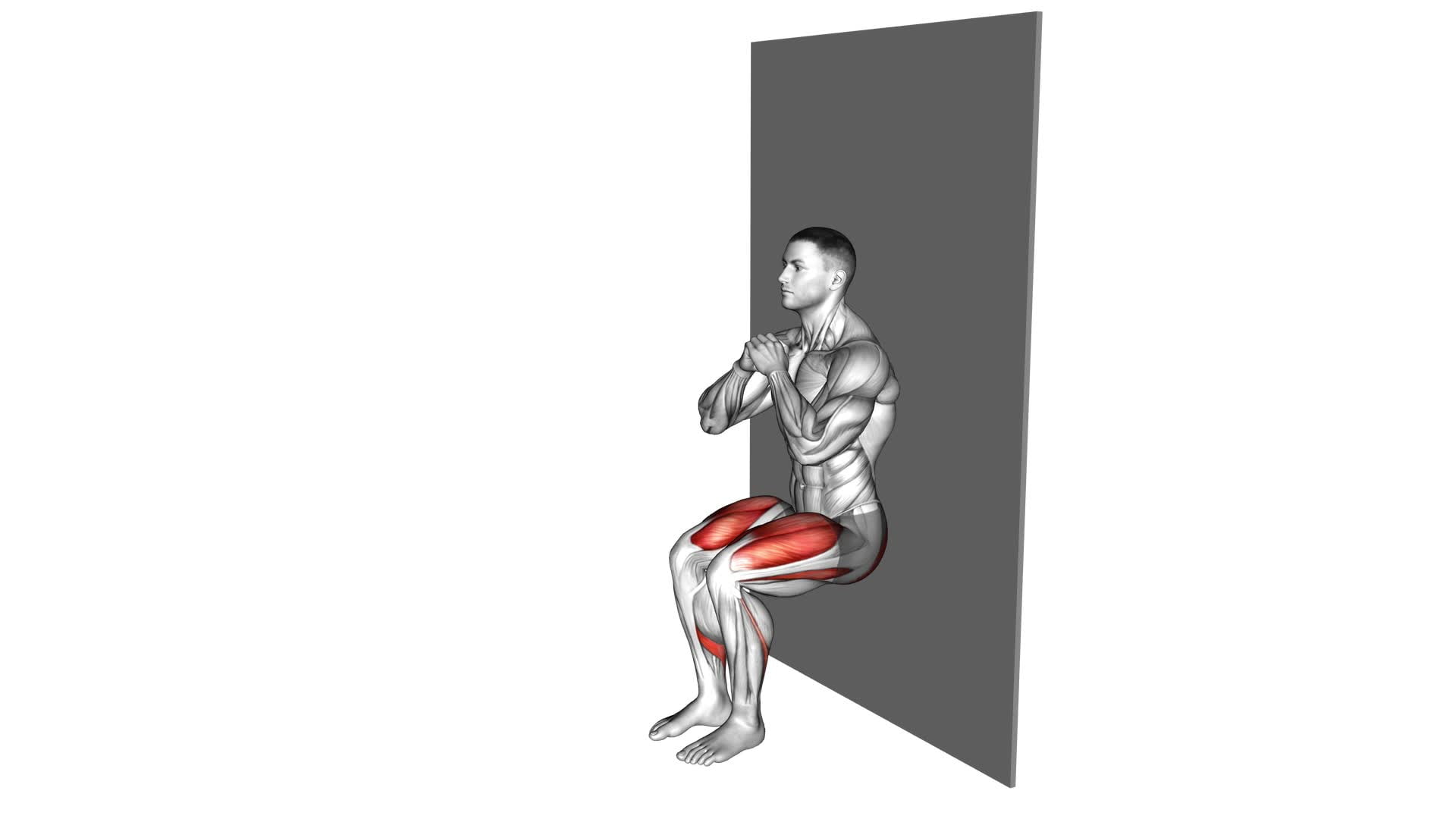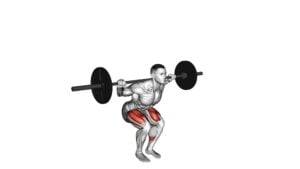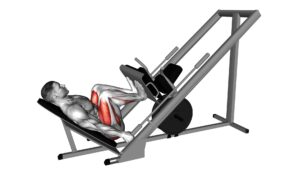Wall Sit (Narrow Stance) (Male) – Video Exercise Guide & Tips

Are you looking for a challenging lower body exercise? Look no further than the wall sit (narrow stance)!
Watch This Exercise Video
In this video exercise guide and tips article, we will show you how to properly perform this exercise, offer variations to push your limits, and give you valuable tips to maximize your workout.
Avoid common mistakes and ensure safety with our helpful instructions.
Get ready to strengthen those legs and feel the burn with this effective exercise!
Key Takeaways
- Wall sit (narrow stance) improves leg strength and builds endurance.
- Proper form and technique, such as maintaining a flat back against the wall and a 90-degree angle in the knees, is crucial for maximizing the effectiveness of the exercise and reducing the risk of injury.
- Deep breathing techniques during the exercise increase oxygen flow to muscles, improve focus, and reduce stress levels.
- There are variations and modifications of wall sit exercises, such as single-leg wall sits and wall sits with weights, that can be adjusted based on fitness level or pre-existing conditions.
Benefits of the Wall Sit (Narrow Stance)
There are numerous benefits to incorporating the wall sit (narrow stance) into your workout routine. This exercise is highly effective in improving leg strength and increasing stability. By assuming the wall sit position, with your back flat against the wall and your feet shoulder-width apart, you engage your leg muscles, particularly the quadriceps, hamstrings, and glutes. Holding this position for a set amount of time, usually 30-60 seconds, helps to build endurance and strengthen these muscles.
The wall sit also improves stability by targeting the muscles in your core and lower body that are responsible for maintaining balance and posture. As you hold the position, you activate your abdominal muscles and lower back, enhancing your overall stability and balance. This is especially beneficial for athletes who rely on strong legs and stability, such as runners, soccer players, and basketball players.
Incorporating the wall sit into your workout routine is a time-efficient way to target multiple muscle groups simultaneously. It requires no equipment and can be done anywhere with a wall. Whether you're a beginner or an experienced athlete, adding the wall sit (narrow stance) to your routine will help you improve leg strength and increase stability, leading to better overall performance in various physical activities.
Proper Form and Technique
To perform the Wall Sit (Narrow Stance) exercise with proper form and technique, it's crucial to focus on correct body alignment and breathing techniques.
Ensure that your back is flat against the wall and your knees are at a 90-degree angle.
Remember to breathe deeply and engage your core throughout the exercise to maximize its benefits.
Correct Body Alignment
Maintain proper body alignment by keeping your back straight and your knees at a 90-degree angle during the wall sit exercise.
Good body posture is essential to ensure maximum muscle engagement and avoid unnecessary strain.
When performing the wall sit, make sure to align your spine against the wall, with your shoulders and hips touching the surface.
Keep your feet shoulder-width apart and press them firmly into the ground. Remember to distribute your body weight evenly on both feet.
This alignment will help engage your quadriceps, hamstrings, glutes, and core muscles effectively.
By maintaining proper body alignment, you'll optimize the benefits of the wall sit exercise and reduce the risk of injury.
Now, let's move on to the next important aspect of exercise – breathing techniques.
Breathing Techniques During Exercise
Breathe deeply and rhythmically to optimize your exercise performance and enhance the effectiveness of your wall sit (narrow stance) workout.
Deep breathing has numerous benefits, including increased oxygen flow to your muscles, improved focus, and reduced stress levels. By taking slow, deliberate breaths, you can activate your parasympathetic nervous system, promoting relaxation and helping you maintain proper form throughout your wall sit.
To practice effective breathing techniques during your workout, inhale deeply through your nose, filling your lungs with air, and exhale slowly through your mouth. Focus on maintaining a steady rhythm, syncing your breath with the movement of your body.
By mastering these breathing techniques, you can enhance the overall effectiveness of your wall sit and achieve greater results.
Now, let's explore some variations to challenge yourself further.
Variations to Challenge Yourself
Push yourself further by incorporating different variations of the wall sit exercise to intensify your workout. By trying out these advanced variations, you can challenge yourself and target different muscles in your lower body.
One variation you can try is the single-leg wall sit. Instead of using both legs, lift one leg off the ground and hold the position with the other leg. This variation will engage your core and glutes even more, as you have to maintain balance and stability.
Another option is the wall sit with weights. Hold dumbbells or a weighted barbell against your thighs while performing the exercise. This added resistance will increase the intensity and help build strength in your legs.
For an even greater challenge, you can try the wall sit with pulses. Instead of holding the position statically, perform small up-and-down movements while maintaining the wall sit position. This will further engage your quads and challenge your endurance.
Remember to listen to your body and start with the basic wall sit before progressing to these advanced variations. Incorporating these different techniques will keep your workouts interesting and help you continue to challenge yourself as you build strength and endurance in your lower body.
Common Mistakes to Avoid
To ensure proper form for the wall sit exercise, it's important to avoid common mistakes.
One mistake to avoid isn't engaging your core throughout the exercise, as this can lead to poor posture and less effective results.
Another mistake is allowing your knees to extend beyond your toes, which can put unnecessary strain on the knees.
Proper Form for Wall Sit
To perform a proper wall sit and avoid common mistakes, you should maintain a narrow stance. This means keeping your feet shoulder-width apart and parallel to each other. By maintaining a narrow stance, you engage your core muscles more effectively, which helps to stabilize your body during the exercise.
To further ensure proper form and avoid mistakes, here are three important tips:
- Keep your back straight against the wall: Avoid leaning forward or rounding your back, as this can strain your lower back and reduce the effectiveness of the exercise.
- Bend your knees to a 90-degree angle: Make sure your thighs are parallel to the ground, with your knees directly above your ankles. This ensures proper alignment and maximizes the benefits of the wall sit.
- Focus on your breathing: Inhale deeply through your nose and exhale slowly through your mouth. This helps to maintain focus and control throughout the exercise.
Importance of Core Engagement
To maintain proper form and avoid common mistakes during a wall sit, it's important for you to engage your core muscles. Core engagement is crucial for maintaining stability and muscle activation throughout the exercise. When you engage your core, you create a strong foundation that supports your body and helps you maintain the correct posture during the wall sit.
This means that your abdominal muscles, lower back muscles, and pelvic floor muscles should be actively contracted. By engaging your core, you not only protect your spine and prevent injury, but you also maximize the effectiveness of the exercise by targeting the muscles in your lower body more efficiently.
Tips for Maximizing Your Workout
Maximize your workout by incorporating these tips for optimal results:
- Vary your exercises: To maximize your workout, it's important to mix up your routine. Incorporating a variety of exercises helps to target different muscle groups, preventing plateaus and keeping your body guessing. Try alternating between strength training exercises, like wall sits, and cardio exercises, such as running or cycling, for a well-rounded workout.
- Incorporate weights: Adding weights to your workout can help increase resistance and intensity, leading to greater muscle development and calorie burn. Whether it's using dumbbells, resistance bands, or even your own body weight, incorporating weights into your exercises can maximize your results. For example, while performing a wall sit, hold a weight plate or dumbbell in front of your chest to increase the challenge.
- Focus on proper form: Proper form is crucial when it comes to maximizing your workout. It ensures that you're targeting the correct muscles and reduces the risk of injury. Take the time to learn the correct technique for each exercise and focus on maintaining good form throughout your workout. This won't only help you achieve better results but also improve your overall fitness and prevent imbalances.
By following these tips, you can take your workout to the next level and maximize your results. Remember to always listen to your body and make adjustments as needed.
Happy exercising!
Safety Precautions and Modifications
Ensure your safety and make necessary modifications while performing the wall sit exercise. Safety should always be a top priority to prevent any potential injuries. Here are some safety precautions and modifications you should consider:
- Firstly, it's important to maintain proper form throughout the exercise. Keep your back straight against the wall and your knees bent at a 90-degree angle. This will help protect your lower back and avoid any unnecessary strain.
- Secondly, listen to your body and adjust the intensity of the exercise accordingly. If you're a beginner or have any pre-existing conditions, you may need to start with a shallower squat position or reduce the duration of the wall sit. Gradually increase the difficulty as your strength and endurance improve.
- Additionally, it's crucial to warm up before attempting the wall sit exercise. Perform some dynamic stretches to prepare your muscles and joints for the workout. This will help prevent muscle strains or pulls.
- Lastly, if you experience any pain or discomfort during the exercise, stop immediately and consult a healthcare professional. It's better to be cautious and seek guidance to avoid further injury.
Frequently Asked Questions
How Long Should I Hold the Wall Sit (Narrow Stance) Position?
To properly perform a wall sit (narrow stance), it's important to know how long to hold the position. The duration of a wall sit can vary depending on your fitness level and goals. Generally, aim to hold the position for 30 seconds to 1 minute.
As you get stronger, you can increase the duration. Incorporating wall sits into your workout routine can help strengthen your leg muscles, improve lower body stability, and increase overall endurance.
Can Wall Sits Help Improve My Posture?
Wall sits can definitely help improve your posture. By strengthening your lower body, including your legs, glutes, and core, wall sits can improve your overall strength and stability. This can lead to better posture, as strong muscles support proper alignment and prevent slouching.
To incorporate wall sits into your daily workout routine, try doing them for 30-60 seconds at a time, gradually increasing the duration as you get stronger. Remember to maintain proper form and engage your muscles throughout the exercise.
Are There Any Specific Muscles Targeted During a Wall Sit (Narrow Stance)?
During a wall sit in a narrow stance, specific muscle groups are targeted. The narrow stance primarily engages your quadriceps, hamstrings, and glutes. This variation of the exercise places more emphasis on these muscles compared to a wider stance.
The benefits of a narrow stance include increased strength and stability in the lower body, improved balance, and enhanced muscular endurance. Incorporating wall sits with a narrow stance into your workout routine can help you achieve these benefits efficiently.
Can Wall Sits Be Modified for Beginners or Individuals With Mobility Restrictions?
Modified variations of wall sits can be beneficial for beginners or individuals with mobility restrictions. By starting with a wider stance and gradually narrowing it, you can gradually increase the intensity. Additionally, using a stability ball against the wall or placing a chair behind you can provide extra support.
Wall sits are an effective exercise that targets the quadriceps, hamstrings, and glutes, making them a great addition to any workout routine for maximum results.
How Often Should I Incorporate Wall Sits Into My Fitness Routine for Maximum Results?
To get maximum results, incorporate wall sits into your fitness routine regularly. Start by doing them a few times a week, and as you progress, aim to do them every other day.
Wall sits are an effective way to strengthen your lower body, especially your quads, glutes, and calves. They also improve your core stability and endurance.
Conclusion
In conclusion, the Wall Sit (Narrow Stance) is a highly effective exercise that targets the lower body and helps improve strength and stability. By maintaining proper form and technique, you can maximize the benefits of this exercise.
Additionally, incorporating variations and avoiding common mistakes will help challenge yourself and prevent injury. Remember to prioritize safety precautions and modifications to ensure a safe and effective workout.
So, get ready to engage your muscles and achieve your fitness goals with the Wall Sit (Narrow Stance)!

Author
Years ago, the spark of my life’s passion ignited in my mind the moment I stepped into the local gym for the first time. The inaugural bead of perspiration, the initial endeavor, the very first surge of endorphins, and a sense of pride that washed over me post-workout marked the beginning of my deep-seated interest in strength sports, fitness, and sports nutrition. This very curiosity blossomed rapidly into a profound fascination, propelling me to earn a Master’s degree in Physical Education from the Academy of Physical Education in Krakow, followed by a Sports Manager diploma from the Jagiellonian University. My journey of growth led me to gain more specialized qualifications, such as being a certified personal trainer with a focus on sports dietetics, a lifeguard, and an instructor for wellness and corrective gymnastics. Theoretical knowledge paired seamlessly with practical experience, reinforcing my belief that the transformation of individuals under my guidance was also a reflection of my personal growth. This belief holds true even today. Each day, I strive to push the boundaries and explore new realms. These realms gently elevate me to greater heights. The unique combination of passion for my field and the continuous quest for growth fuels my drive to break new ground.







